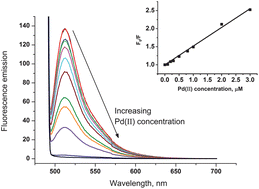One-step synthesis of fluorescein modified nano-carbon for Pd(ii) detection via fluorescence quenching
Abstract
Carbon black (CB)

* Corresponding authors
a
Department of Chemistry, Physical and Theoretical Chemistry Laboratory, University of Oxford, South Parks Road, Oxford OX1 3QZ, UK
E-mail:
richard.compton@chem.ox.ac.uk
Fax: +44 (0)1865 275 410
Tel: +44 (0)1865 275 413
Carbon black (CB)

 Please wait while we load your content...
Something went wrong. Try again?
Please wait while we load your content...
Something went wrong. Try again?
J. Panchompoo, L. Aldous, M. Baker, M. I. Wallace and R. G. Compton, Analyst, 2012, 137, 2054 DOI: 10.1039/C2AN16261J
To request permission to reproduce material from this article, please go to the Copyright Clearance Center request page.
If you are an author contributing to an RSC publication, you do not need to request permission provided correct acknowledgement is given.
If you are the author of this article, you do not need to request permission to reproduce figures and diagrams provided correct acknowledgement is given. If you want to reproduce the whole article in a third-party publication (excluding your thesis/dissertation for which permission is not required) please go to the Copyright Clearance Center request page.
Read more about how to correctly acknowledge RSC content.
 Fetching data from CrossRef.
Fetching data from CrossRef.
This may take some time to load.
Loading related content
